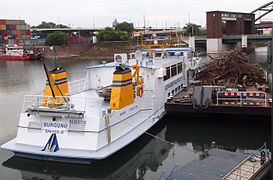Burgundy (ship)
|
Burgundy in action at the Loreley on February 8, 2011
|
||||||||||||
|
||||||||||||
|
||||||||||||
|
||||||||||||
|
||||||||||||
The Burgundy is a measuring and research vessel for the Rhine and its navigable tributaries. The main areas of application are the Upper and Middle Rhine between Speyer and Koblenz and the Moselle . The Burgundy entered service in 1988. The ship is subordinate to the Ministry for the Environment, Energy, Food and Forests in Rhineland-Palatinate and is officially designated as MS Burgund by them.
tasks
The ship is used for general water monitoring in Rhineland-Palatinate. In the 43 m² laboratory on board, the water samples can be examined for oxygen content, pH value, electrical conductivity, ammonium , chlorophyll and solar radiation. In addition, photometric determination of nitrogen and phosphorus compounds and titrimetric determination of chloride are also possible. Water and sediment samples can be preserved on board.
The data processing system is set up for online measurement. The water to be examined is continuously fed to the individual examination points via three permanently installed water extraction points in the bow and on the port side. Suspended matter samples are taken with a flow centrifuge. With the built-in echograph system, the water depth is measured and sediment explorations carried out.
The ship is also used for environmental training. Groups of up to 25 people can travel with them and use the laboratory facilities on board.
The Burgundy was during the salvage of the Waldhof used in monitoring the acid discharge into the Rhine, while about four and a half weeks 24 hours a day throughout the service.
See also
Web links
- Information about the ship
- Responsibilities of Burgundy , with link to PDF (658 kB) and flyer
Individual evidence
- ↑ Deutschlandfunk: Between the Sandoz catastrophe and the Waldhof accident (accessed on November 17, 2019)


